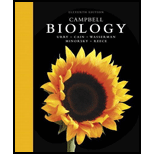
Campbell Biology (11th Edition)
11th Edition
ISBN: 9780134093413
Author: Lisa A. Urry, Michael L. Cain, Steven A. Wasserman, Peter V. Minorsky, Jane B. Reece
Publisher: PEARSON
expand_more
expand_more
format_list_bulleted
Concept explainers
Question
Chapter 53, Problem 53.4CR
Summary Introduction
To analyze: The reasons for the ecological “trade-offs” to be common.
Introduction: The “ecological tradeoff” means the potential of the parent speciesto give birth to the offspring. It depends upon the availability of the food
Expert Solution & Answer
Want to see the full answer?
Check out a sample textbook solution
Students have asked these similar questions
Please draw in the missing answer, thank you
Please fill in all blank questions, Thank you
please fill in missing parts , thank you
Chapter 53 Solutions
Campbell Biology (11th Edition)
Ch. 53.1 - DRAW IT Each female of a particular fish species...Ch. 53.1 - Prob. 2CCCh. 53.1 - Prob. 3CCCh. 53.2 - Explain why a constant per capita rate of growth...Ch. 53.2 - Prob. 2CCCh. 53.2 - Prob. 3CCCh. 53.3 - Explain why a population that fits the logistic...Ch. 53.3 - WHAT IF? Given the latitudinal differences in...Ch. 53.3 - Prob. 3CCCh. 53.4 - Identify three key life history traits, and give...
Ch. 53.4 - Prob. 2CCCh. 53.4 - Prob. 3CCCh. 53.5 - Prob. 1CCCh. 53.5 - WHAT IF? Suppose you were studying a species that...Ch. 53.5 - Prob. 3CCCh. 53.6 - How does a human population's age structure affect...Ch. 53.6 - How have the rate and number of people added to...Ch. 53.6 - WHAT IF? Type "personal ecological footprint...Ch. 53 - Gray whales (Eschrichtius robustus) gather each...Ch. 53 - Suppose one population has an r that is twice as...Ch. 53 - Prob. 53.3CRCh. 53 - Prob. 53.4CRCh. 53 - Density-dependent factors regulate population...Ch. 53 - The human population is no longer growing...Ch. 53 - Population ecologists follow the fate of same-age...Ch. 53 - A population's carrying capacity (A) may change as...Ch. 53 - Scientific study of the population cycles of the...Ch. 53 - Analyzing ecological footprints reveals that (A)...Ch. 53 - Based on current growth rates, Earth's human...Ch. 53 - The observation that members of a population are...Ch. 53 - According to the logistic growth equation...Ch. 53 - During exponential growth, a population always (A)...Ch. 53 - Which of the following statements about human...Ch. 53 - Prob. 10TYUCh. 53 - EVOLUTION CONNECTION Contrast the selective...Ch. 53 - Prob. 12TYUCh. 53 - Prob. 13TYUCh. 53 - WRITE ABOUT A THEME: INTERACTIONS In a short essay...Ch. 53 - SYNTHESIZE YOUR KNOWLEDGE Locusts (grasshoppers in...
Knowledge Booster
Learn more about
Need a deep-dive on the concept behind this application? Look no further. Learn more about this topic, biology and related others by exploring similar questions and additional content below.Similar questions
- please draw in the answers, thank youarrow_forwarda. On this first grid, assume that the DNA and RNA templates are read left to right. DNA DNA mRNA codon tRNA anticodon polypeptide _strand strand C с A T G A U G C A TRP b. Now do this AGAIN assuming that the DNA and RNA templates are read right to left. DNA DNA strand strand C mRNA codon tRNA anticodon polypeptide 0 A T G A U G с A TRParrow_forwardplease answer all question below with the following answer choice, thank you!arrow_forward
- please draw in the answeres, thank youarrow_forwardA) What is being shown here?B) What is indicated by the RED arrow?C) What is indicated by the BLUE arrow?arrow_forwardPlease identify the curve shown below. What does this curve represent? Please identify A, B, C, D, and E (the orange oval). What is occurring in these regions?arrow_forward
- Please identify the test shown here. 1) What is the test? 2) What does the test indicate? How is it performed? What is CX? 3) Why might the test be performed in a clinical setting? GEN CZ CX CPZ PTZ CACarrow_forwardDetermine how much ATP would a cell produce when using fermentation of a 50 mM glucose solution?arrow_forwardDetermine how much ATP would a cell produce when using aerobic respiration of a 7 mM glucose solution?arrow_forward
- Determine how much ATP would a cell produce when using aerobic respiration to degrade one small protein molecule into 12 molecules of malic acid, how many ATP would that cell make? Malic acid is an intermediate in the Krebs cycle. Assume there is no other carbon source and no acetyl-CoA.arrow_forwardIdentify each of the major endocrine glandsarrow_forwardCome up with a few questions and answers for umbrella species, keystone species, redunant species, and aquatic keystone speciesarrow_forward
arrow_back_ios
SEE MORE QUESTIONS
arrow_forward_ios
Recommended textbooks for you
 Concepts of BiologyBiologyISBN:9781938168116Author:Samantha Fowler, Rebecca Roush, James WisePublisher:OpenStax College
Concepts of BiologyBiologyISBN:9781938168116Author:Samantha Fowler, Rebecca Roush, James WisePublisher:OpenStax College Biology (MindTap Course List)BiologyISBN:9781337392938Author:Eldra Solomon, Charles Martin, Diana W. Martin, Linda R. BergPublisher:Cengage Learning
Biology (MindTap Course List)BiologyISBN:9781337392938Author:Eldra Solomon, Charles Martin, Diana W. Martin, Linda R. BergPublisher:Cengage Learning Human Biology (MindTap Course List)BiologyISBN:9781305112100Author:Cecie Starr, Beverly McMillanPublisher:Cengage Learning
Human Biology (MindTap Course List)BiologyISBN:9781305112100Author:Cecie Starr, Beverly McMillanPublisher:Cengage Learning Biology Today and Tomorrow without Physiology (Mi...BiologyISBN:9781305117396Author:Cecie Starr, Christine Evers, Lisa StarrPublisher:Cengage Learning
Biology Today and Tomorrow without Physiology (Mi...BiologyISBN:9781305117396Author:Cecie Starr, Christine Evers, Lisa StarrPublisher:Cengage Learning Biology: The Dynamic Science (MindTap Course List)BiologyISBN:9781305389892Author:Peter J. Russell, Paul E. Hertz, Beverly McMillanPublisher:Cengage Learning
Biology: The Dynamic Science (MindTap Course List)BiologyISBN:9781305389892Author:Peter J. Russell, Paul E. Hertz, Beverly McMillanPublisher:Cengage Learning

Concepts of Biology
Biology
ISBN:9781938168116
Author:Samantha Fowler, Rebecca Roush, James Wise
Publisher:OpenStax College

Biology (MindTap Course List)
Biology
ISBN:9781337392938
Author:Eldra Solomon, Charles Martin, Diana W. Martin, Linda R. Berg
Publisher:Cengage Learning

Human Biology (MindTap Course List)
Biology
ISBN:9781305112100
Author:Cecie Starr, Beverly McMillan
Publisher:Cengage Learning

Biology Today and Tomorrow without Physiology (Mi...
Biology
ISBN:9781305117396
Author:Cecie Starr, Christine Evers, Lisa Starr
Publisher:Cengage Learning

Biology: The Dynamic Science (MindTap Course List)
Biology
ISBN:9781305389892
Author:Peter J. Russell, Paul E. Hertz, Beverly McMillan
Publisher:Cengage Learning
